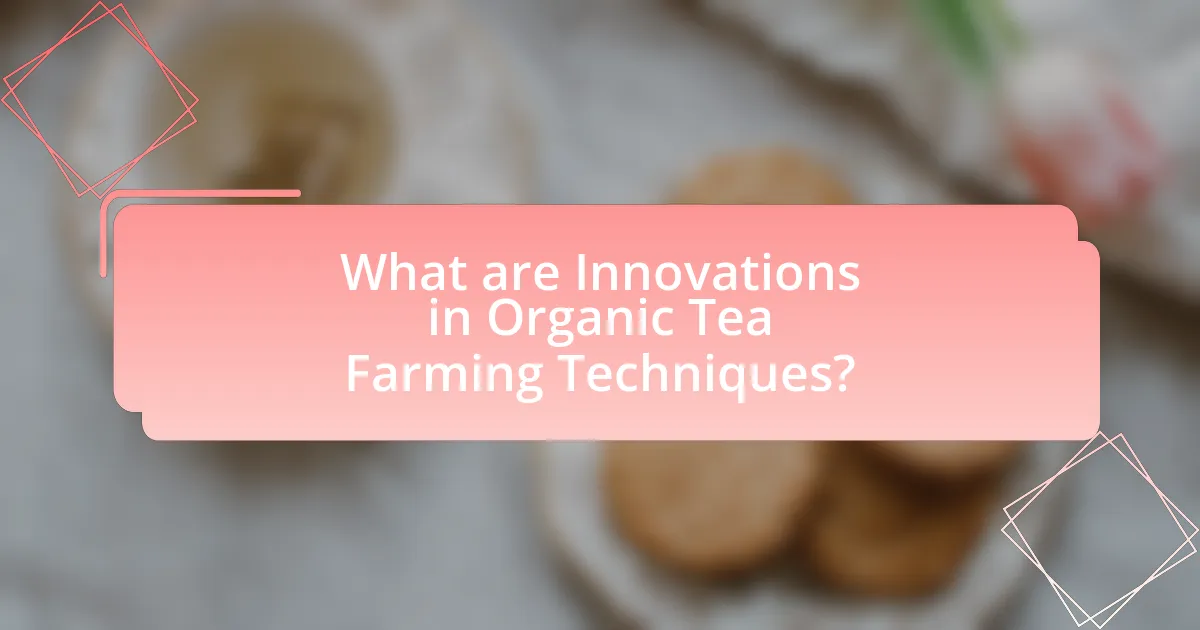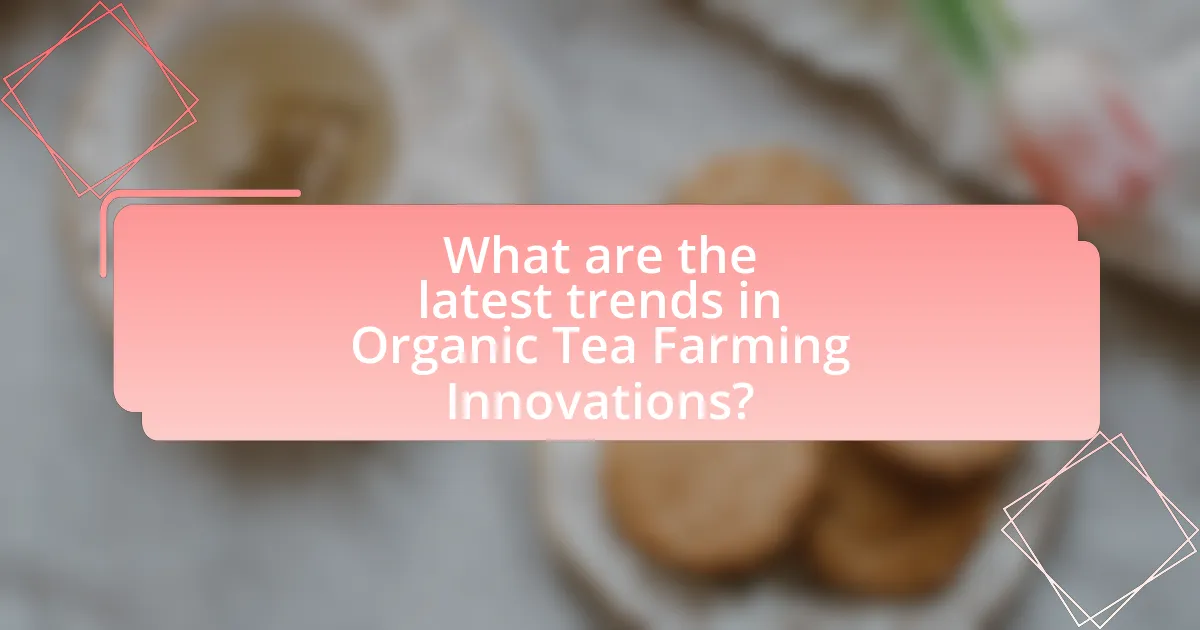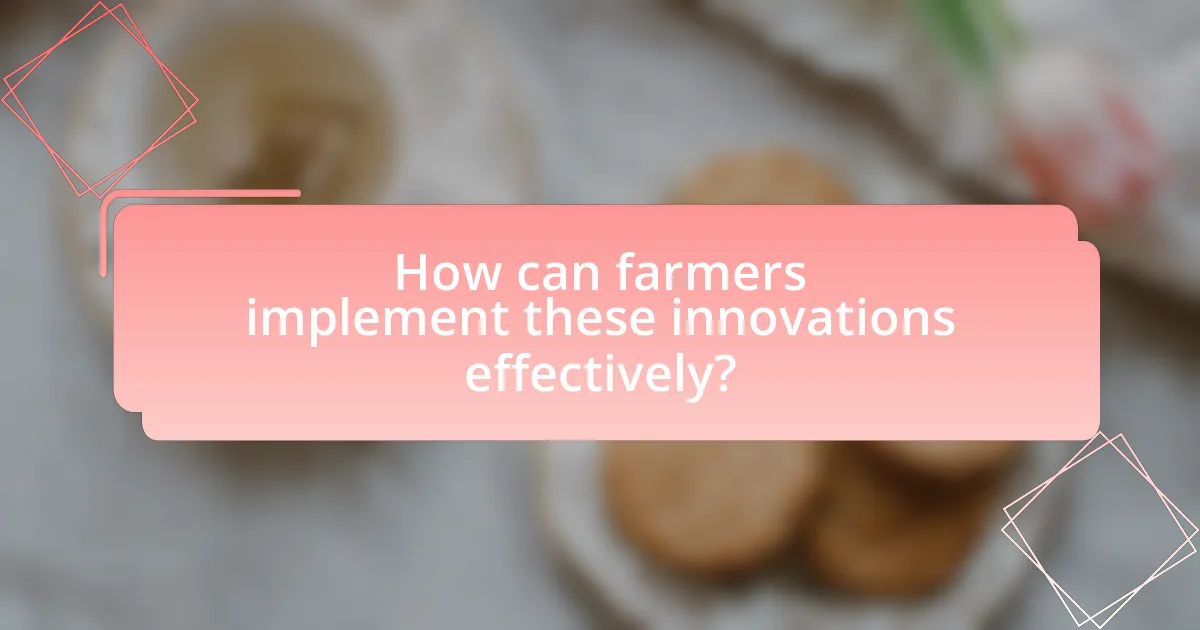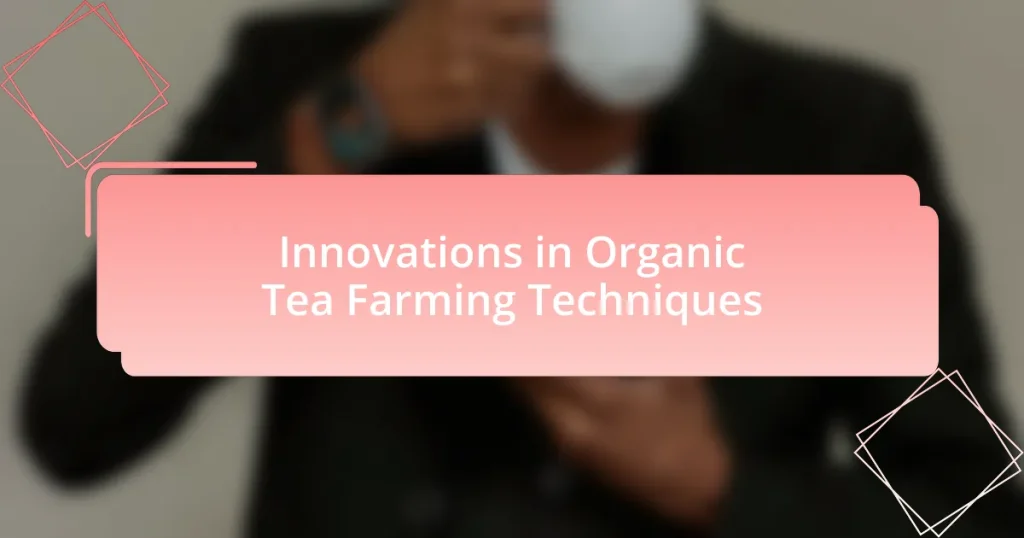Innovations in organic tea farming techniques encompass advanced practices such as precision agriculture, integrated pest management, and agroforestry. These methods leverage technology, including drones and soil sensors, to optimize resource use and enhance crop yields, while promoting sustainability and reducing chemical dependency. The article explores how these innovations differ from traditional farming methods, their impact on tea quality and sustainability, and the economic viability they offer to farmers. Additionally, it highlights emerging trends, challenges faced by the organic tea industry, and best practices for successful implementation of these innovative techniques.

What are Innovations in Organic Tea Farming Techniques?
Innovations in organic tea farming techniques include the use of precision agriculture, integrated pest management, and agroforestry practices. Precision agriculture employs technology such as drones and soil sensors to optimize resource use and enhance crop yields, which has been shown to increase efficiency by up to 30%. Integrated pest management combines biological control methods with minimal chemical interventions, reducing pesticide use by 50% while maintaining crop health. Agroforestry practices, which involve planting tea alongside other crops and trees, improve biodiversity and soil health, leading to a 20% increase in overall farm productivity. These innovations collectively contribute to sustainable farming practices and improved economic viability for tea farmers.
How do these innovations differ from traditional tea farming methods?
Innovations in organic tea farming techniques differ from traditional tea farming methods primarily through the use of advanced technology and sustainable practices. Traditional methods often rely on chemical fertilizers and pesticides, while innovations emphasize organic inputs, precision agriculture, and integrated pest management. For example, the adoption of drone technology for monitoring crop health allows farmers to apply resources more efficiently, reducing waste and environmental impact. Additionally, innovations such as soil health management and agroforestry practices enhance biodiversity and soil fertility, contrasting with the monoculture approach typical of traditional farming. These advancements not only improve yield and quality but also promote ecological sustainability, as evidenced by studies showing that organic practices can lead to healthier ecosystems and better long-term productivity.
What specific practices are considered innovative in organic tea farming?
Innovative practices in organic tea farming include the use of agroforestry systems, integrated pest management (IPM), and soil health enhancement techniques. Agroforestry systems involve planting tea alongside other crops and trees, which promotes biodiversity and improves ecosystem services. Integrated pest management employs biological control methods, such as introducing beneficial insects, to reduce reliance on synthetic pesticides. Soil health enhancement techniques, such as composting and cover cropping, improve soil fertility and structure, leading to healthier tea plants. These practices are supported by research indicating that they can increase yield and sustainability in organic tea production.
How do these practices impact tea quality and sustainability?
Innovations in organic tea farming techniques significantly enhance tea quality and sustainability. These practices, such as crop rotation, composting, and integrated pest management, improve soil health and biodiversity, leading to higher-quality tea leaves. For instance, studies show that organic tea farms can produce leaves with higher antioxidant levels compared to conventional farms, which is linked to healthier soil ecosystems. Additionally, sustainable practices reduce chemical runoff and promote environmental conservation, ensuring that tea production does not compromise future agricultural viability. This dual focus on quality and sustainability is supported by research indicating that organic farming can increase yield stability over time, making it a viable long-term solution for tea cultivation.
Why is innovation important in organic tea farming?
Innovation is important in organic tea farming because it enhances productivity, sustainability, and quality. By adopting new techniques such as precision agriculture, farmers can optimize resource use, reduce waste, and improve crop yields. For instance, the integration of technology like soil sensors and drones allows for better monitoring of crop health and soil conditions, leading to more informed decision-making. Additionally, innovative pest management strategies, such as the use of beneficial insects and organic pesticides, help maintain ecological balance while ensuring high-quality tea production. These advancements not only meet the growing consumer demand for organic products but also contribute to environmental conservation, making innovation a crucial element in the future of organic tea farming.
What challenges does the organic tea industry face that necessitate innovation?
The organic tea industry faces significant challenges such as pest management, soil fertility, and climate change, which necessitate innovation. For instance, organic farmers often struggle with pests that can devastate crops, as they cannot use synthetic pesticides. This leads to the need for innovative pest control methods, such as integrated pest management (IPM) techniques, which combine biological control with cultural practices. Additionally, maintaining soil fertility without chemical fertilizers requires the adoption of innovative practices like crop rotation and the use of organic compost. Climate change further complicates these issues by altering growing conditions, prompting the industry to explore resilient tea varieties and sustainable farming practices. These challenges highlight the urgent need for innovation to ensure the sustainability and productivity of organic tea farming.
How can innovation improve the economic viability of organic tea farming?
Innovation can improve the economic viability of organic tea farming by enhancing productivity, reducing costs, and increasing market access. For instance, the adoption of precision agriculture technologies, such as soil sensors and drone monitoring, allows farmers to optimize resource use, leading to higher yields and lower input costs. A study by the International Tea Committee indicates that farms utilizing such technologies can increase their output by up to 30%. Additionally, innovations in pest management, such as integrated pest management (IPM) techniques, reduce reliance on chemical inputs, thereby lowering production costs and appealing to environmentally conscious consumers. Furthermore, digital marketing platforms enable farmers to reach broader markets directly, increasing sales opportunities and potentially raising profit margins. These innovations collectively contribute to a more sustainable and profitable organic tea farming sector.

What are the latest trends in Organic Tea Farming Innovations?
The latest trends in organic tea farming innovations include the adoption of precision agriculture technologies, which enhance crop management through data-driven insights. Farmers are increasingly utilizing drones and satellite imagery to monitor plant health, optimize irrigation, and manage pest control more effectively. Additionally, the integration of organic fertilizers and biopesticides is gaining traction, as these methods improve soil health and reduce chemical dependency. Research indicates that these innovations can lead to higher yields and better quality tea, aligning with consumer demand for sustainable and eco-friendly products.
How are technology and research influencing organic tea farming?
Technology and research are significantly enhancing organic tea farming by introducing precision agriculture techniques and innovative pest management solutions. Precision agriculture utilizes data analytics and IoT devices to monitor soil health, moisture levels, and crop growth, allowing farmers to optimize resource use and improve yield quality. For instance, a study published in the Journal of Agricultural Science demonstrated that using soil sensors increased organic tea yields by 20% due to better water management. Additionally, research into biopesticides and organic fertilizers has led to more effective pest control methods that align with organic farming principles, reducing reliance on synthetic chemicals. This integration of technology and research not only boosts productivity but also promotes sustainability in organic tea farming practices.
What role do precision agriculture and data analytics play in organic tea farming?
Precision agriculture and data analytics significantly enhance organic tea farming by optimizing resource use and improving crop yields. These technologies enable farmers to monitor soil health, moisture levels, and pest populations in real-time, allowing for targeted interventions that reduce waste and increase efficiency. For instance, a study published in the Journal of Agricultural Science found that precision agriculture techniques can lead to a 20-30% increase in crop yields while minimizing the environmental impact. By leveraging data analytics, farmers can analyze historical data and predict future trends, facilitating better decision-making regarding planting schedules and resource allocation. This integration of technology not only supports sustainable practices but also enhances the overall productivity of organic tea farms.
How are new pest management techniques being integrated into organic practices?
New pest management techniques are being integrated into organic practices through the adoption of biological control methods, precision agriculture, and the use of natural pesticides. These methods enhance pest control while adhering to organic standards. For instance, the introduction of beneficial insects, such as ladybugs and parasitic wasps, effectively reduces pest populations without chemical inputs. Additionally, precision agriculture technologies, including drones and sensors, allow farmers to monitor pest activity in real-time, enabling targeted interventions that minimize environmental impact. Research published in the Journal of Organic Agriculture highlights that these integrated approaches not only improve pest management efficiency but also promote biodiversity and soil health, aligning with the principles of organic farming.
What sustainable practices are emerging in organic tea farming?
Emerging sustainable practices in organic tea farming include agroforestry, integrated pest management (IPM), and soil health enhancement techniques. Agroforestry involves planting tea alongside trees, which improves biodiversity and soil quality while providing shade. Integrated pest management employs biological controls and natural predators to reduce chemical pesticide use, promoting a healthier ecosystem. Soil health enhancement techniques, such as composting and cover cropping, improve soil fertility and structure, leading to better tea quality and yield. These practices are supported by research indicating that agroforestry can increase biodiversity by up to 50% and that IPM can reduce pesticide use by 30-50%, demonstrating their effectiveness in sustainable organic tea farming.
How does agroforestry contribute to organic tea farming innovations?
Agroforestry enhances organic tea farming innovations by integrating trees and shrubs with tea cultivation, which improves biodiversity and soil health. This practice leads to increased resilience against pests and diseases, reducing the need for chemical inputs. Research indicates that agroforestry systems can increase tea yields by up to 30% while promoting sustainable land use. Additionally, the shade provided by trees can improve the quality of tea leaves, as it helps maintain optimal moisture levels and reduces temperature extremes. These benefits demonstrate how agroforestry practices can drive innovation in organic tea farming, aligning with sustainable agricultural goals.
What are the benefits of using cover crops in organic tea cultivation?
Using cover crops in organic tea cultivation enhances soil health, improves biodiversity, and reduces erosion. Cover crops, such as legumes and grasses, contribute to soil fertility by fixing nitrogen and increasing organic matter, which supports tea plant growth. Additionally, they provide habitat for beneficial insects and microorganisms, promoting a balanced ecosystem. Research indicates that cover crops can reduce weed pressure and improve water retention in the soil, leading to more sustainable tea farming practices.

How can farmers implement these innovations effectively?
Farmers can implement innovations in organic tea farming effectively by adopting precision agriculture techniques, which utilize data analytics and technology to optimize resource use. For instance, employing soil sensors can help farmers monitor nutrient levels and moisture content, allowing for targeted fertilization and irrigation. Research from the University of California found that precision agriculture can increase crop yields by up to 20% while reducing input costs by 15%. Additionally, integrating pest management systems that rely on biological controls rather than chemical pesticides can enhance sustainability and reduce environmental impact. Implementing these strategies not only improves productivity but also aligns with organic farming principles, ensuring compliance with certification standards.
What training and resources are available for farmers adopting new techniques?
Farmers adopting new techniques in organic tea farming can access various training programs and resources designed to enhance their skills and knowledge. These include workshops offered by agricultural extension services, online courses from universities, and hands-on training sessions organized by non-governmental organizations focused on sustainable agriculture. For instance, the International Tea Committee provides resources and guidelines on best practices in tea cultivation. Additionally, farmers can utilize online platforms like e-learning modules and webinars that cover innovative farming techniques, pest management, and organic certification processes. These resources are essential for improving productivity and sustainability in organic tea farming.
How can farmers assess the suitability of innovations for their specific conditions?
Farmers can assess the suitability of innovations for their specific conditions by conducting field trials and evaluating the performance of new techniques in their local environment. Field trials allow farmers to compare the effectiveness of innovations against traditional practices, taking into account local soil types, climate conditions, and pest pressures. Research indicates that localized testing can lead to a 20-30% increase in yield when farmers adopt innovations that are well-suited to their specific conditions, as demonstrated in studies conducted by the International Tea Research Institute. Additionally, farmers can seek feedback from peer networks and agricultural extension services to gather insights on the practical application of innovations in similar contexts.
What are the common pitfalls to avoid when implementing new organic farming techniques?
Common pitfalls to avoid when implementing new organic farming techniques include inadequate soil preparation, neglecting pest management, and insufficient training for farmers. Inadequate soil preparation can lead to poor crop yields, as organic farming relies heavily on soil health; studies show that well-prepared soil enhances nutrient availability and microbial activity, which are crucial for plant growth. Neglecting pest management can result in crop losses, as organic methods often require different strategies than conventional farming; for instance, integrated pest management techniques are essential to control pests without synthetic chemicals. Lastly, insufficient training for farmers can hinder the successful adoption of new techniques; research indicates that farmers who receive proper education on organic practices are more likely to implement them effectively, leading to better outcomes in yield and sustainability.
What best practices should farmers follow when innovating in organic tea farming?
Farmers should adopt integrated pest management (IPM), soil health enhancement, and sustainable water usage as best practices when innovating in organic tea farming. IPM involves using biological control methods and natural pesticides to manage pests, which reduces chemical dependency and promotes biodiversity. Enhancing soil health through organic compost and cover cropping improves nutrient availability and soil structure, leading to healthier tea plants. Sustainable water usage, such as rainwater harvesting and drip irrigation, conserves water resources and ensures efficient irrigation practices. These practices are supported by research indicating that organic farming methods can increase yield and improve environmental sustainability, as shown in studies published by the Rodale Institute, which found that organic systems can yield 20% more than conventional systems under drought conditions.
How can farmers measure the success of their innovative practices?
Farmers can measure the success of their innovative practices by evaluating key performance indicators such as yield increases, cost reductions, and improvements in soil health. For instance, a study published in the Journal of Sustainable Agriculture found that implementing organic farming techniques led to a 20% increase in tea yields over three years compared to conventional methods. Additionally, farmers can assess the economic viability of their practices by analyzing profit margins and market demand for organic tea, which has seen a 30% growth in consumer interest according to market research by Grand View Research. Monitoring these metrics allows farmers to make informed decisions about the effectiveness of their innovations in organic tea farming.
What role does community support play in successful innovation adoption?
Community support is crucial for successful innovation adoption in organic tea farming techniques. It fosters collaboration among farmers, enabling knowledge sharing and resource pooling, which enhances the implementation of new practices. For instance, studies have shown that communities that actively engage in training programs and workshops experience a 30% higher adoption rate of innovative farming techniques compared to those without such support. This collaborative environment not only builds trust but also encourages experimentation and reduces the perceived risks associated with adopting new methods.


